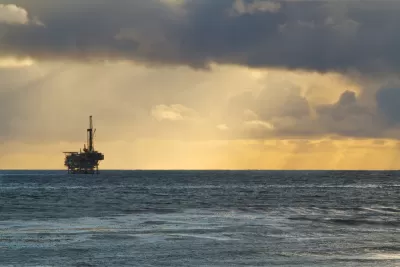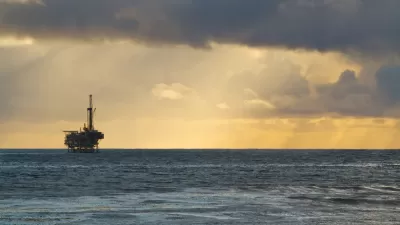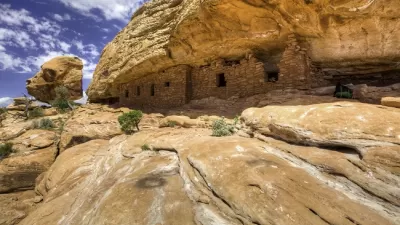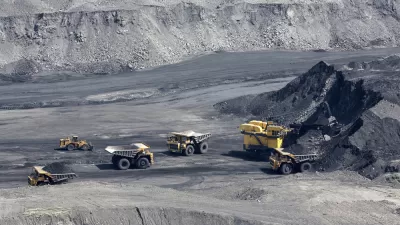So much for that so-called "permanent" ban that President Obama enacted by President Obama in December to end oil and gas drilling in the Arctic Ocean and off the central-northern Atlantic coast.

President Trump's America First Energy Plan now has an "America First Offshore Energy Strategy," in the form of an executive order signed on Friday, April 28 that initiates the process to reverse the marine protection enacted in December for much of the Alaskan coast and Atlantic coast from Virginia to Maine.
The executive order implementing an America-first offshore energy strategy "aims to expand offshore drilling in the Arctic and Atlantic Oceans, as well as assess whether energy exploration can take place in marine sanctuaries in the Pacific and Atlantic," reports July Eilperin for The Washington Post.
Speaking to reporters Thursday night, Interior Secretary Ryan Zinke said it would likely take about two years to do a thorough review of what new areas could be put up for auction.
According to the U.S. Department of Interior's press release, the executive order "aims to expand offshore oil and gas exploration and production in the Outer Continental Shelf (OCS) through a review of the five-year leasing program and reconsideration of certain regulations pertaining to offshore energy potential."
“This executive order, coupled with the President’s January 30th order on reducing regulations and the March 28th order on energy independence, puts us on track for American energy independence," stated Zinke.
The order includes the clause, "minimizing unnecessary regulatory burdens," a central theme of the Trump Administration as it believes that by doing so, it will "allow this wealth to pour into our communities," said President Donald J. Trump.
Not so fast
"Still, even Trump administration officials said it would take years to rewrite federal leasing plans and open up these areas to drilling," clarifies Eilperin.
As noted in the the December post on President Obama's "permanent drilling ban" off sections of the Alaskan and Atlantic coasts, by using the 1953 Outer Continental Shelf Lands Act rather than an executive order, "Obama made it legally difficult for Republican President-elect Donald Trump's administration to reverse this action."
Pacific Coast response
"Friday’s order will also direct Wilbur Ross, the commerce secretary — who has jurisdiction over marine sanctuaries — to conduct a review of all such sanctuaries created over the past 10 years, and not to create any new sanctuaries during that review period," reports Coral Davenport for The New York Times. This is the clause that relates to drilling off the Pacific Coast.
Paul Rogers, natural resources and environment reporter for The Mercury News, reports that "[a]ny attempt to actually open new areas off California’s coast to new oil and gas drilling would be met with certain lawsuits from environmentalists, state officials, fishing groups and tourism leaders. And on Friday one California legislator wasted no time saying she would sponsor a bill aimed at foiling Trump’s plan."
That legislator, State Senator Hannah-Beth Jackson (D-Santa Barbara), has long fought to prevent drilling off the California coast. On April 17, she applauded the decommissioning on an oil platform off the Santa Barbara County coast. Putting more oil platforms off The Golden State's coastline will not prove easy.
Governors from the three West Coast states: Washington Governor Jay Inslee, California Governor Edmund G. Brown Jr., and Oregon Governor Kate Brown issued a statement on April 28 in response to President Trump's executive order calling the "unilateral action shortsighted."
For good reason there has been no federal expansion of oil and gas drilling along our shared coastline for more than 30 years. We still remember what happened in Santa Barbara in 1969, Port Angeles in 1985, Grays Harbor in 1988 and Coos Bay in 1999.
Now is not the time to turn back the clock. We cannot return to the days where the federal government put the interests of big oil above our communities and treasured coastline.
Remember the BP Oil Spill of 2010?
The Times' Davenport also reports that the executive order directs Secretary Zinke to review oil rig safety regulations that his predecessor enacted after the explosion of the Deepwater Horizon on April 20 that killed 11 and spilled 4.9 million barrels of oil into the sea.
Related in Planetizen:
-
President Obama Enacts Permanent Drilling Ban Along Arctic and Atlantic Coasts, December 22, 2016: In a precedent-setting action that supporters call creative and opponents view as abusive, President Obama has declared a permanent drilling ban off the Atlantic coast from Virginia to Maine and along much of the Alaska coast. But will it last?
FULL STORY: Trump signs executive order to expand drilling off America’s coasts: ‘We’re opening it up.’

Planetizen Federal Action Tracker
A weekly monitor of how Trump’s orders and actions are impacting planners and planning in America.

Chicago’s Ghost Rails
Just beneath the surface of the modern city lie the remnants of its expansive early 20th-century streetcar system.

San Antonio and Austin are Fusing Into one Massive Megaregion
The region spanning the two central Texas cities is growing fast, posing challenges for local infrastructure and water supplies.

Since Zion's Shuttles Went Electric “The Smog is Gone”
Visitors to Zion National Park can enjoy the canyon via the nation’s first fully electric park shuttle system.

Trump Distributing DOT Safety Funds at 1/10 Rate of Biden
Funds for Safe Streets and other transportation safety and equity programs are being held up by administrative reviews and conflicts with the Trump administration’s priorities.

German Cities Subsidize Taxis for Women Amid Wave of Violence
Free or low-cost taxi rides can help women navigate cities more safely, but critics say the programs don't address the root causes of violence against women.
Urban Design for Planners 1: Software Tools
This six-course series explores essential urban design concepts using open source software and equips planners with the tools they need to participate fully in the urban design process.
Planning for Universal Design
Learn the tools for implementing Universal Design in planning regulations.
planning NEXT
Appalachian Highlands Housing Partners
Mpact (founded as Rail~Volution)
City of Camden Redevelopment Agency
City of Astoria
City of Portland
City of Laramie





























